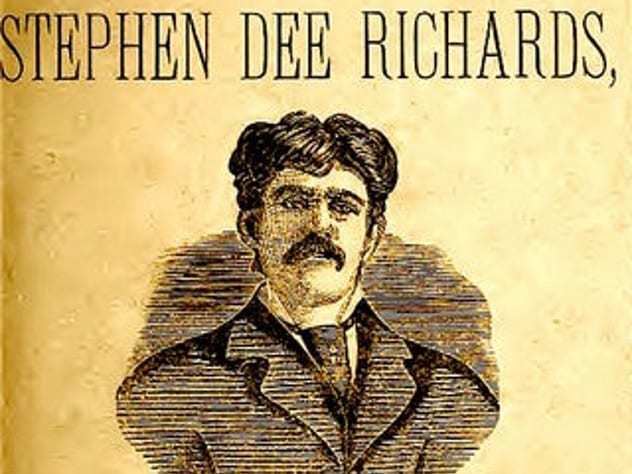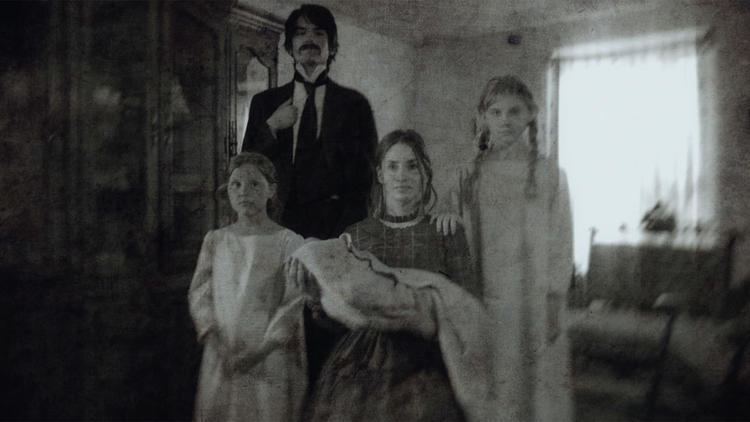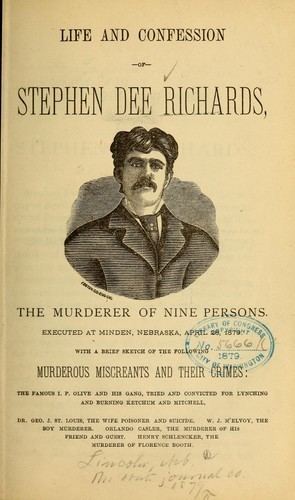Name Stephen Richards Role Murderer | Victims 6-9 Date apprehended December 1878 Country United States | |
 | ||
Born c. 1856 (age 23) Wheeling, West Virginia Other names F.A. Hoge, Dee Richards, Dick Richards, George Gallagher, D.J. Roberts, William Hudson, W.A. Littleton, J. Littleton, The Nebraska Fiend | ||
Cause of death Execution by hanging Criminal penalty Execution by hanging Died January 15, 1879 (aged 23), Kearney, Nebraska, United States | ||
Stephen D. Richards (died 1879) was an American serial killer.
Contents

Photographic representation not actual Image.
Background
Richards was born in Wheeling, West Virginia and raised as a Quaker. His birthdate was March 18, but his birth year is uncertain. The Omaha Herald reported that Richards said he was born in 1836, but the New York Times reported that he was 24 years old when apprehended in December 1878, indicating that he was born around 1854. Richards' statements that he was a child during the Civil War, which lasted from 1861 to 1865, and that he was between 16 and 18 in September 1871, when his mother died, corroborate an 1850s birthdate.

As a young child, Richards moved with his family to Ohio, where he grew up in Jefferson County. Around 1875, he moved west to Iowa and worked for one year at the Iowa Lunatic Asylum in Mount Pleasant, where his job was to bury dead patients. The New York Times reported that Richards "had his finer senses blunted" during his time at the asylum; the Omaha Herald reported that he said of this job, "That took away to some extent my feeling and sympathy for mankind. I could stand by a man and see him die with no more feeling than I would have for a hog. When I left there... I didn't care for anything and had no respect for human nature."
After leaving his job at the asylum, Richards drifted through Kansas, Colorado, and Wyoming, where he found intermittent work and occasionally consorted with groups of train robbers.
Murders
In early 1878 Richards got into a dispute with his traveling companion, shot him, and left the corpse lying where it had fallen. According to the New York Times, this murder took place in Kansas, but the Omaha Herald reported that it happened in the Sand Hills near Kearney, Nebraska. Reports also differ on the date of this murder: the Times said it happened before February 1878, when Richards arrived in Kearney, while the Herald said it happened on March 19, 1878. The victim had been traveling with Richards for two or three weeks. He was the son of a Hastings, Iowa farmer, and Richards thought he was about 20 years old but could not recall his name. Richards described the circumstances of this murder:
We had raised up in our blankets and had not put on our boots when I made some careless remark about a trifling matter. He says "That's a damned lie." "It's a good thing you don't mean all you say," I told him. "But I do mean it," he said. "You don't want to mean it," I said; and he picked up his revolver and saying, "Here is something that backs all that I say," cocked it. I looked at him, and thought, "The fool acts as if he means to shoot," and skipping out my little 33 I plugged him one in the head. That was the first trouble we had ever had.
In February 1878, Richards arrived in Kearney, Nebraska, where a month later in March he committed some minor crime and was jailed. Just before Richards' arrival in the Kearney jail, two other inmates - a horse-thief named Harelson (also spelled Harolson) and a train robber named either Underwood or Nixon - had escaped. Harelson's common-law wife had been jailed based on suspicion that she helped her husband escape, and she met Richards when he arrived in the Kearney jail. Soon after Richards was jailed, Mrs. Harelson was released, and she invited Richards to visit her at her Kearney County homestead. When Richards, in turn, was released, he began visiting Mrs. Harelson frequently, and eventually decided to kill her and her family so he could take possession of their homestead. (The Omaha Herald provides a differing account of how Richards met Mrs. Harelson, stating that she was never imprisoned, but that she gave Richards credit for breaking her husband out of jail and invited him to visit her out of gratitude.)
In late October 1878, Mrs. Harelson made plans to move to Texas, where her husband was living, and arranged to sell Richards her homestead. In the early morning, some day in the first week of November - the Times reported November 2, while the Herald reported November 3 - Richards murdered Mrs. Harelson, her two daughters, and her infant son with an axe as they slept, then buried their bodies on the property and left to sell the Harelsons' belongings in nearby Hastings. A few days later, he returned, paid off Mrs. Harelson's outstanding debts, and took possession of the Harelson homestead. (Richards later denied reports that he murdered the crying infant son by taking hold of his leg and smashing his head against the floor, telling reporters that none of the Harelsons awoke before they were killed.)
Richards lived at the Harelson homestead for most of 1878, having successfully made it appear that Mrs. Harelson and her children had moved away without incident. Later that year, he befriended his neighbor, a Swedish immigrant named Peter Anderson. On December 8 or 9, Anderson became ill after eating a meal Richards had prepared, causing him to suspect Richards had poisoned him. Anderson told a neighbor of his suspicions, then confronted Richards, leading to a fight in which Richards beat Anderson to death with a hammer or hatchet. (Richards denied poisoning Anderson, saying using poison wasn't his style, and claimed that he killed in self-defense after Anderson attacked him with a knife.)
Capture
Richards fled Kearney on horseback after killing Anderson. The Times account of Richards' crimes says:
That evening a party of neighbors came up to inquire after Anderson, and found Richards hitching up the Swede's team. He told them to go into the house and see, and then threw off the harness from one of the animals, mounted him, and made for Bloomington.
He traveled east by horse, train, and foot, passing through Omaha, Chicago, Wheeling, and Bridgeport, Ohio before reaching Mount Pleasant, Ohio, where he was arrested. He had spent about two weeks on the run. Ohio authorities jailed him in Steubenville, where he wrote two articles confessing to his crimes for the local newspaper. Sheriff Anderson of Buffalo County and Sheriff Martin of Kearney County, who had pursued Richards all the way from Nebraska to Ohio, returned with him to Kearney. According to the Times, Richards nearly evaded capture in Ohio:
"If [Sheriff] Anderson hadn't been so quick in coming," said Richards, "he wouldn't have got me. The day I was caught I was going to start back for Nebraska. Why? Because they never would have thought of me coming West again, and would have gone on East, while I would have passed by here and gone to the mountains. But I went to a ball the night before I was caught, and if it hadn't been for that - but, anyhow, if I hadn't had the two girls with me, I guess the constable, McGrew, who arrested me, would have been a dead man - either of us would, for I'd have shot."
Execution
Richards was jailed in Kearney on December 28, 1878, and hanged there on January 15, 1879. "Richards manifested supreme indifference to his lot, was perfectly willing to be brought direct to Kearney Junction, and said he had as soon died one way as another," the Omaha Herald reported upon his return to Nebraska. As many as nine murders have been attributed to him, but Richards himself confessed to only six: those of his traveling companion, the four Harelsons, and Peter Anderson (although he suggested to a Herald reporter that, while traveling through Kansas in 1876, he killed a man who tried to rob him).
